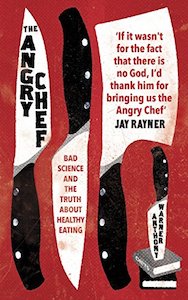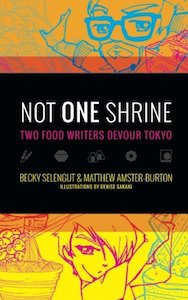The Angry Chef: Bad Science and the Truth About Healthy Eating by Anthony Warner. Oneworld Publications, 2017. 9781786072160.
 Sarah: I went to Seattle’s cookbook bookstore, Book Larder, and ended up buying a bunch. I highly recommend this bookstore because they don’t have everything, they just have good things. I grabbed several cookbooks plus this one, because the summary of it said it’s exactly the kind of thing I like to read. It’s by this guy with a background in cooking and in chemistry who is angry about fad diets and the bad science and the bad dietary advice they propagate. He covers some of the more recent fad diets and what’s wrong with them, and then has chapters in between where he talks about how to think more critically, more scientifically, how to ask the questions that you need to ask, why you might seem to have good results from a diet even if it doesn’t really work, and how people will recommend a diet if they think it has an effect but if it doesn’t they won’t discourage you.
Sarah: I went to Seattle’s cookbook bookstore, Book Larder, and ended up buying a bunch. I highly recommend this bookstore because they don’t have everything, they just have good things. I grabbed several cookbooks plus this one, because the summary of it said it’s exactly the kind of thing I like to read. It’s by this guy with a background in cooking and in chemistry who is angry about fad diets and the bad science and the bad dietary advice they propagate. He covers some of the more recent fad diets and what’s wrong with them, and then has chapters in between where he talks about how to think more critically, more scientifically, how to ask the questions that you need to ask, why you might seem to have good results from a diet even if it doesn’t really work, and how people will recommend a diet if they think it has an effect but if it doesn’t they won’t discourage you.
Gene: If it doesn’t have an effect?
S: So if you try the amazing new whatever diet and it doesn’t do anything for you, are you going to put a testimonial to that effect on the website promoting the diet?
G: Probably not.
S: So I picked it up, expecting to love it because it’s exactly my speed. But I ended up not loving it.
G: Not loving this book?
S: Because it turns out I’ve already read this information. I’m already aware of all of the things he’s talking about, and he covers more of the how to think critically part and less about the crazy diets and where they came from. I ended up skimming to the parts about the new crazy diets and how they originated. I think it’s a good book, but it’s the wrong time for me to read it. This book would have been great for me twenty years ago.
G: Where did you get that information, did you find it in diet books and on websites?
S: I have read other, similar works by medical people and people writing general debunking and critical thinking books. It’s a genre that I read.
G: So you’re wowed by this book because it’s all there.
S: It’s all there! It’s all in one book.
G: And you’ve read enough on the subject that you know it’s good.
S: It’s really good!
G: But this is not the book for you right now because you have read enough books on critical thinking, especially about diets, that what you would get from this book you already have.
S: Exactly!
G: This is a new kind of Book Wow! So it did wow you, you just didn’t need to read it.
S: Right! He has this really great chapter explaining regression to the mean where he explains the concept in a really clear way with an example from his life.
G: What was it?
S: He had this sous chef, mostly he did fine, but every once in a while he would do terribly, he would really mess up in the kitchen. Then he’d get yelled at and the next day he would be better. And every once in a while he would have an awesome day and his bosses would think he finally was getting the hang of this and then the day after, he would drop back to his normal level again. But the author and another chef were talking about this, trying to figure out how help him. The author tried to be encouraging when he did really well, but the other guy only ever yelled at him when he sucked. Now he’s realizing that the whole thing was regression to the mean. The highs and the lows… if you have a really high day, do the best you’ve ever done, you’re not going to stay at the highest point, you’re going to drift back to your average. The worst day you’ve ever had, same thing. So if your health is terrible, and you don’t have a degenerative condition, you’re going to feel better eventually no matter what you do. No matter what diet you try, if you feel cruddy, eventually you’re going to feel better. And the reverse is the same, if you do really awesome, you’re going to get back to normal at some point. It’s this thing that makes an effect appear to happen with all sorts of interventions. If you’re doing a scientific study, you need to have various controls to spot this. He talks about how it’s very difficult to spot, and the whole idea of regression to the mean is recent, it’s only been around since the late 1800s, even though people have been evaluating information like this for a long time. But this was really hard to see.
G: This kind of non-effect effect.
S: You see something happen, but it didn’t happen for the reason you think it did.
G: So things seem to work for you because you are generally OK. Whatever you’re doing is OK. If you feel super-shitty after you ate X, then you feel better when you eat Y, you think you feel better because you ate Y, but not really. You just feel better because you generally feel better.
S: Yeah, and they have to control for this in medicine, when they test a new drug, because that’s exactly what happens with everything. The author says people will ask him, “If this guy feels better after he stops eating gluten, what’s the harm?” and he says that it’s because it’s really limiting your diet, it’s hard to get all the nutrients you need. People who legit have celiac disease have to be super careful. And people will tend to keep eliminating more and more things from their diet.
G: Yeah, that’s interesting.
S: And he has a very carefully-written chapter about eating disorders. He says that he had previously made this statement, that now he realizes is incorrect and apologizes for saying it and for being insensitive about it, and he’d had a lot of people talk to him and correct him: he had said that these fad diets cause people to get eating disorders. Now he says that it isn’t that they cause eating disorders, but people may have an underlying susceptibility to eating disorders and sometimes the thing that triggers them or maybe is the first sign of eating disorders manifesting is that they start doing Clean Eating, which is a particular type of fad diet. You’ll talk to someone who works at an eating disorder clinic and they’ll say, “Oh, yeah, like 90 percent of people in this clinic started out with Clean Eating.”
G: What is Clean Eating?
S: It designates certain foods as “dirty” and certain foods as “clean.” Theoretically it’s emphasizing eating more vegetables, eating less processed food, but it ends up giving people a huge array of foods to avoid, that they must remember which are good and which are bad. You end up eliminating the bad foods, and feeling happy that you were able to eliminate the bad foods, that you are good and not bad. It’s really appealing to the part of your brain that can get disordered. The idea of cleanliness, the idea of goodness, the idea of purity associated with your eating really sinks its claws into the part of you that wants to have an eating disorder.
G: Is this like when people talk about a cleanse? Like a blueberry cleanse?
S: I think there’s some overlap, but I think it’s slightly different. (There’s a good overview of it in The Guardian by food writer Bee Wilson.)
You’re going to see it everywhere now, it’s been a fad for maybe five years. I had been seeing books on Clean Eating at the library and wondered, “Clean? How so?”
A lot of this originated on his blog and he talks about how it has changed based on input from his readers, people who wrote in and gave him more context and more information.

